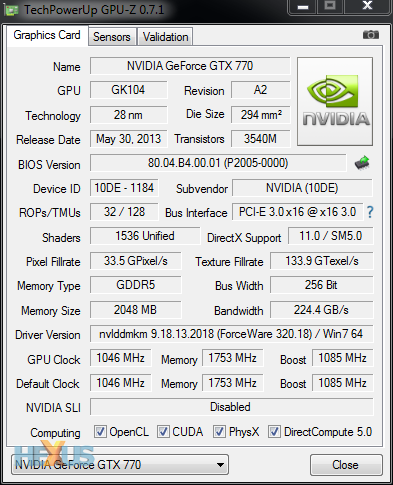Testing methodology
GeForce GTX 770 2GB specs |
|---|
 |
GPU Comparisons |
||||||||
|---|---|---|---|---|---|---|---|---|
| Graphics Card | GPU Clock (MHz) |
Stream Processors |
Shader Clock (MHz) |
Memory Clock (MHz) |
Memory Bus (bits) |
Graphics Driver | Approx Price | |
| Nvidia GeForce GTX Titan 6GB | 837 (876) | 2,688 | 837 (876) | 6,008 | 384 | GeForce 320.14 | £800 | |
| Nvidia GeForce GTX 780 3GB | 863 (902) | 2,304 | 863 (902) | 6,008 | 384 | GeForce 320.18 | £550 | |
| Nvidia GeForce GTX 770 2GB | 1,046 (1,085) | 1,536 | 1,046 (1,085) | 7,010 | 256 | GeForce 320.18 | £330 | |
| Nvidia GeForce GTX 680 2GB | 1,006 (1,058) | 1,536 | 1,006 (1,058) | 6,008 | 256 | GeForce 320.14 | £360 | |
| Nvidia GeForce GTX 580 1.5GB | 772 | 512 | 1,544 | 4,008 | 256 | GeForce 320.14 | NA | |
| AMD Radeon HD 7970 GHz 3GB | 1,000 (1,050) | 2,048 | 1,000 (1,050) | 6,000 | 384 | Catalyst 13.5 beta 2 | £325 | |
| AMD Radeon HD 7970 3GB | 925 | 2,048 | 925 | 5,500 | 384 | Catalyst 13.5 beta 2 | £275 | |
| AMD Radeon HD 7950 3GB | 850 | 1,792 | 850 | 5,000 | 384 | Catalyst 13.5 beta 2 | £225 | |
| AMD Radeon HD 5870 1GB | 850 | 1,600 | 800 | 4,800 | 256 | Catalyst 13.5 beta 2 | NA | |
HEXUS High-End Test Bench |
||||||||||||
|---|---|---|---|---|---|---|---|---|---|---|---|---|
| Processor | Intel Core i7-3770K (3.50GHz, 8MB cache, quad-core) | |||||||||||
| CPU Cooler | Intel reference E97378-001 | |||||||||||
| Motherboard | Gigabyte GA-Z77X-UP4 TH | |||||||||||
| Memory | 8GB G.Skill RipJaws (2x4GB) DDR3 @ 1,600MHz | |||||||||||
| Power Supply | Corsair AX750W | |||||||||||
| Storage Device | Samsung 830 Series 256GB SSD | |||||||||||
| Optical Drive | Generic 24x DVD-RW | |||||||||||
| Chassis | Corsair Graphite Series 600T | |||||||||||
| Monitor | Dell 3007FPW | |||||||||||
| Operating system | Windows 7 Ultimate (64-bit, SP1) | |||||||||||
Testing notes
10 high-end GPUs all tested from the grounds-up. We've identified GTX 770's main competitor is the Radeon HD 7970 GHz, priced at similar levels, so it makes sense to keep an eye on comparative performance.
Specifying reference frequencies is actually a poor proxy for in-game performance. This is due to the way in which the card(s), particularly Nvidia's, GPU Boost to higher frequencies that differ depending upon environmental conditions. We noted the highest core frequency for each real-world game and list them below.
| BioShock | Call of Duty | Crysis 3 | DiRT | Far Cry 3 | Just Cause 2 |
|---|---|---|---|---|---|
| 1,136.6MHz | 1,136.6MHz | 1,136.6MHz | 1,136.6MHz | 1,097.4MHz | 1,136.6MHz |
As expected, the GPU races past the 'average' 1,085MHz in-game frequency prescribed by Nvidia. The sample managed to hold the above-quoted frequency for the vast majority of the time during the benchmarking runs, too. Your mileage may vary, considerably so, but we suspect most partner cards will also replicate this seemingly excessive (and welcome) GPU Boosting.
We've removed the results of dual-GPU beasts such as the GTX 690 and HD 7990 because they cloud the issue. For those that want to cross-check the results (on the same drivers), please head on over to here.









